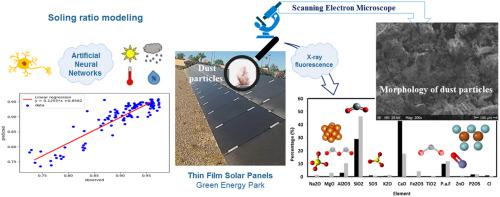当前位置:
X-MOL 学术
›
Sol. Energy Mater. Sol. Cells
›
论文详情
Our official English website, www.x-mol.net, welcomes your
feedback! (Note: you will need to create a separate account there.)
Experimental investigation and modeling of photovoltaic soiling loss as a function of environmental variables: A case study of semi-arid climate
Solar Energy Materials and Solar Cells ( IF 6.3 ) Pub Date : 2021-03-01 , DOI: 10.1016/j.solmat.2020.110874 Houssain Zitouni , Alae Azouzoute , Charaf Hajjaj , Massaab El Ydrissi , Mohammed Regragui , Jesús Polo , Ayoub Oufadel , Abdellatif Bouaichi , Abdellatif Ghennioui
Solar Energy Materials and Solar Cells ( IF 6.3 ) Pub Date : 2021-03-01 , DOI: 10.1016/j.solmat.2020.110874 Houssain Zitouni , Alae Azouzoute , Charaf Hajjaj , Massaab El Ydrissi , Mohammed Regragui , Jesús Polo , Ayoub Oufadel , Abdellatif Bouaichi , Abdellatif Ghennioui

|
Abstract Photovoltaic technology is still developing in the MENA region. Nevertheless, soiling remains a major cause for performance loss in PV Modules. In this work, the soiling rate is modeled as a function of environmental data with several modeling methods such as the multiple linear regression model (MLR), multiple linear regression with interaction model (MLRWI), the mathematical model generated by the response surface methodology (RSM) and Artificial Neural Networks (ANNs), by using one-year of ground measurements from an amorphous array with a capacity of 2.16 kWc. The experiment is carried under a semi-arid climate at Green Energy Park research facility (Benguerir, Morocco). The dust analysis was carried out by Scanning Electron Microscope (SEM), Energy Dispersive X-Ray Spectroscopy (EDS), and X-ray fluorescence (XRF) in two periods (December 2017 and June 2018) in order to define the mineralogy and morphology of our dust samples. The results of this study show that, the daily energy drop reaches 0.43 kWh/day and 0.61 kW/h/day in the dry period and 0.03 kW/h/day in the rainy period, where the expected produced energy is 5.59 KWh/day. The daily performance ratio drop reaches an average of 6.1%/day and 1.6%/day in the dry and rainy period respectively. During the dry period the soiling ratio reaches an average of 0.35%/day. The MLR method marked the lowest correlation with r2 = 0.23, this correlation improved to reach r2 = 0.48 by using the MLRWI method. ANN model shows the best performance and accuracy with r2 = 0.813 and around 0.026 in the RMSE indicator.
中文翻译:

作为环境变量函数的光伏污染损失的实验研究和建模:以半干旱气候为例
摘要 光伏技术在中东和北非地区仍在发展。尽管如此,污染仍然是导致光伏组件性能下降的主要原因。在这项工作中,污染率被建模为环境数据的函数,使用多种建模方法,如多元线性回归模型 (MLR)、具有相互作用模型的多元线性回归 (MLRWI)、响应面方法生成的数学模型 ( RSM) 和人工神经网络 (ANN),通过使用容量为 2.16 kWc 的非晶阵列进行一年的地面测量。该实验是在绿色能源公园研究机构(摩洛哥本盖尔)的半干旱气候下进行的。粉尘分析通过扫描电子显微镜 (SEM)、能量色散 X 射线光谱 (EDS)、和 X 射线荧光 (XRF) 在两个时期(2017 年 12 月和 2018 年 6 月),以定义我们尘埃样本的矿物学和形态。本研究结果表明,日能耗下降分别为旱季0.43千瓦时/天和0.61千瓦/小时/天,雨季0.03千瓦/小时/天,预计发电量为5.59千瓦时/天. 旱季和雨季的日性能比下降分别达到平均6.1%/天和1.6%/天。在干旱期间,脏污率平均达到 0.35%/天。MLR 方法的相关性最低,r2 = 0.23,通过使用 MLRWI 方法,这种相关性提高到 r2 = 0.48。ANN 模型在 RMSE 指标中显示出最佳性能和准确度,r2 = 0.813,约为 0.026。
更新日期:2021-03-01
中文翻译:

作为环境变量函数的光伏污染损失的实验研究和建模:以半干旱气候为例
摘要 光伏技术在中东和北非地区仍在发展。尽管如此,污染仍然是导致光伏组件性能下降的主要原因。在这项工作中,污染率被建模为环境数据的函数,使用多种建模方法,如多元线性回归模型 (MLR)、具有相互作用模型的多元线性回归 (MLRWI)、响应面方法生成的数学模型 ( RSM) 和人工神经网络 (ANN),通过使用容量为 2.16 kWc 的非晶阵列进行一年的地面测量。该实验是在绿色能源公园研究机构(摩洛哥本盖尔)的半干旱气候下进行的。粉尘分析通过扫描电子显微镜 (SEM)、能量色散 X 射线光谱 (EDS)、和 X 射线荧光 (XRF) 在两个时期(2017 年 12 月和 2018 年 6 月),以定义我们尘埃样本的矿物学和形态。本研究结果表明,日能耗下降分别为旱季0.43千瓦时/天和0.61千瓦/小时/天,雨季0.03千瓦/小时/天,预计发电量为5.59千瓦时/天. 旱季和雨季的日性能比下降分别达到平均6.1%/天和1.6%/天。在干旱期间,脏污率平均达到 0.35%/天。MLR 方法的相关性最低,r2 = 0.23,通过使用 MLRWI 方法,这种相关性提高到 r2 = 0.48。ANN 模型在 RMSE 指标中显示出最佳性能和准确度,r2 = 0.813,约为 0.026。











































 京公网安备 11010802027423号
京公网安备 11010802027423号